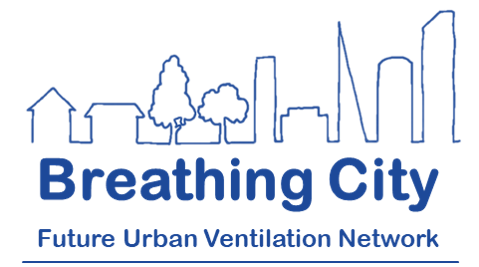The Future Urban Ventilation Network (FUVN) is a UKRI funded research network, under the 2020 SPF Clean Air Programme, that brings together researchers and practitioners across the UK to develop a new “Breathing City” methodology to manage exposure to air pollution by considering the airflows between indoor and outdoor environments.
Our vision is to define a new integrated health evidenced approach to urban and building ventilation design for vulnerable communities – The Breathing City. Quantifying and managing health risks from air pollution relies on understanding how airflows transport pollutants through urban and indoor environments resulting in human exposure. Together, we will:
- define a new holistic methodology to evaluate coupled indoor-outdoor flows in the context of air quality challenges for health, together with impacts on thermal comfort, noise and energy use;
- place health outcomes at the heart of building and city design to enable planners, architects, engineers and communities to design, manage, adapt and use urban environments, to address inequalities and minimise air quality exposures for those most at risk from the effects of air pollutants.
- engage researchers, clinicians, practitioners, policy makers, regulators and the public to scope this new approach and provide leadership to the research and impact activities needed to make it a reality.
In June 2021 we published a Scoping Document setting out the key challenges and opportunities that can shape the future of ventilation in urban settings.
Need for a New Approach
Our cities are already changing, and will evolve significantly over the next century. Changes in emissions sources, urbanisation and climate change as well as technology and lifestyle will impact on the mix of pollutants in the outdoor and indoor environments as well as the potential for controlling exposure to these pollutants. As we gain more evidence for the health effects of particular pollutants it is imperative that we have a set of tools to adapt our built environments to respond effectively to the changing threats associated with air quality. Inequality compounds the impacts of poor air quality and we therefore need approaches that consider the interaction between the people, buildings and the city, and at the same time “design out” high air quality risk zones that impact the most vulnerable. This defines the context for our overarching grand challenge – how can we advance modelling, measurement, technology, design, guidance and policy to allow the integrated ventilation of cities, buildings and people without costing the earth?
Our primary focus is the physics of the indoor-outdoor exchange, and how through understanding this we can develop innovative new solutions to tackle current and future air quality challenges. Human exposure to air pollution is underpinned by airflows – the flow at different scales within the external environment, the air exchange between indoor spaces and the outdoors, the flow within buildings, and the flow in and around the human body. These airflows disperse, transport, dilute and deposit airborne pollutants and are fundamental to determining aspects such as rates of reactions for complex air chemistry. However these airflows don’t just determine air quality, they are also a major influence on the thermal environment, humidity, noise and energy demand of a city. Being able to accurately model airflows and how they transport pollutants is at the heart of being able to make accurate predictions of future scenarios and developing effective solutions; innovation in urban design, ventilation solutions and air cleaning technologies all require a significant understanding of the fluid dynamics that determines the physics of pollutant transport.
